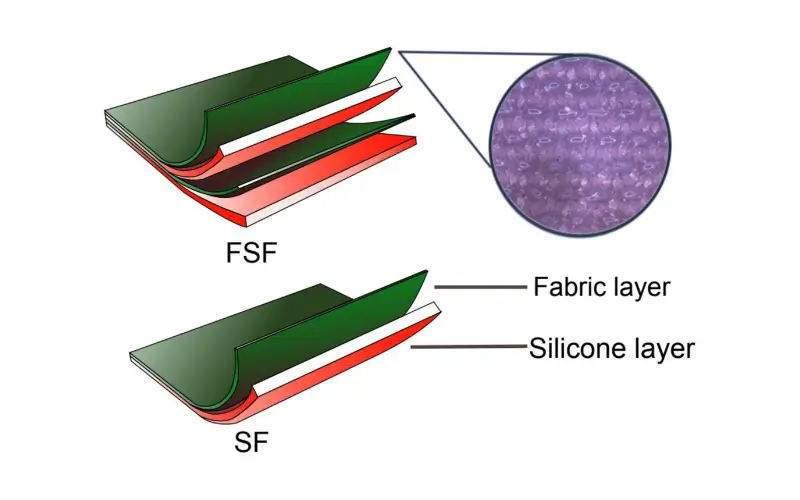Modern fabrics depend on moisture-wicking textile technologies to keep sweat away from the skin and provide comfort and performance. Silicone in technical textiles improves moisture management. Performance textiles coated with silicone improve breathability and durability. Advanced moisture management from silane-treated moisture-wicking textiles keeps clothing lightweight and pleasant even under tough situations. Silicone coatings prevent moisture-wicking fabrics from wear and strain. Thus, silicone-enhanced fabric technology has become necessary to creating high-performance textiles with greater functionality and durability for various applications.

How Does Moisture-Wicking Textile Technology Work?
Skin sweat is transferred to the fabric’s outer surface using moisture-wicking textile technology, where it dissipates fast. This keeps the wearer dry and comfortable throughout exercise. Silicone improves moisture-wicking textiles’ hydrophobic and hydrophilic equilibrium. Silicone applications in technical textiles enable for effective moisture transport while preserving breathability.
By strengthening fabric fiber bonds, silane-treated moisture-wicking textiles improve this process. This treatment improves moisture control and fabric durability. Thus, silane in breathable fabric technology improves durability.
Silicone-enhanced fabrics are softer and more flexible. This makes silicone-treated performance fabrics perfect for activewear and outdoor gear. Silicone-coated moisture-wicking textiles are durable enough to endure numerous washings. Silicone and silane innovations in fabrics reinvent moisture management and offer cutting-edge solutions for modern textiles.
Benefits of Silicone-Coated Moisture-Wicking Fabrics
Silicone coatings in technical textiles increase moisture management by transferring perspiration from the skin to the surface. This mechanism rapidly evaporates moisture. Silicone balances hydrophobic and hydrophilic qualities in moisture-wicking materials.
Silane-treated moisture-wicking textiles cover fabric fibers uniformly and durably to improve breathability. This treatment improves airflow and keeps the fabric light and flexible. Additionally, silane for advanced textile performance improves the fabric’s structure. Silane-treated fabrics are great for outdoor and activewear due to these properties.
Performance fabrics coated with silicone are durable and long-lasting. After repeated washing and use, silicone-coated moisture-wicking textiles remain effective. Silicone-enhanced fabric technology further improves softness and elasticity. Silicone and silane innovations in fabrics redefine moisture-wicking textile technology for varied settings and activities.
Common Moisture-Wicking Textile Materials
Polyester and nylon are extensively utilized because they wick moisture from the skin. The hydrophobic characteristics of these synthetic fibers repel water and dissipate sweat quickly. For current applications, especially in demanding situations, these materials sometimes lack sophisticated performance attributes.
Silicone and silane in breathable fabric technology have improved moisture management. Silicone improves hydrophobic and hydrophilic equilibrium in moisture-wicking fabrics. Silane-treated moisture-wicking textiles’ robust fiber bond improves ventilation and retains the fabric’s lightweight structure. These advances make sportswear and outdoor gear more comfortable and functional.
The durability and adaptability of moisture-wicking fabrics have also been enhanced by innovations in silicone and silane for advanced textile performance. Even after multiple washings, silicone-treated performance fabrics last. Moisture-wicking fabrics with silicone coatings are soft and flexible. These innovations elevate moisture-wicking textile technology for a variety of sectors and activities.
Moisture-Wicking Clothing Care
Moisture-wicking silicone-coated fabrics last longer with proper care. Always wash silicone-treated performance fabrics in cold water with mild detergent. Silicone can be damaged by harsh chemicals or fabric softeners.
Special care is needed to dry these textiles. Silicone coatings are best preserved by air drying. Machine drying should be done at low heat to avoid damage. Silicone applications in technical textiles can deteriorate at high temperatures. Avoid ironing silicone-treated surfaces since direct heat can damage them.
These fabrics need proper storage too. To avoid mildew and odor, store silicone-coated moisture-wicking materials in a cool, dry place. Avoid creases that may stress silicone-treated areas by folding clothes carefully. Following these best practices will ensure silicone-enhanced fabric technology provides appropriate moisture management and long-term performance for varied applications.
Does Moisture-Wicking Textile Technology Work in All Climates?
Because it regulates moisture and maintains comfort, moisture-wicking textile technology works in many conditions. Silicone-enhanced fabric technology quickly evaporates sweat in hot and humid environments. Silicone’s hydrophobic characteristics in moisture-wicking materials minimize moisture buildup.
Silane for moisture management in textiles is necessary in colder climates to avoid saturation. Moisture-wicking fabrics with silicone coatings keep inner layers dry. Silane-treated moisture-wicking materials breathe.
Silicone applications in technical textiles are suited for a variety of situations thanks to their adaptability. Silicone-treated performance fabrics control moisture and last in harsh heat or cold. Silane in breathable fabric technology makes these textiles more adaptable. Moisture-wicking textile technology provides comfort and functionality in all climates and activities thanks to these advancements.
Fabric Innovations with Silicone and Silane
Silicone and silane uses for technical textiles have transformed moisture-wicking textile technology. Silicone improves hydrophobic and hydrophilic equilibrium in moisture-wicking fabrics. Silane-treated moisture-wicking textiles bind with fabric fibers to improve performance and durability. These developments have spread moisture-wicking fabrics to sportswear, outdoor gear, and medical textiles.
Moisture-wicking textile technologies will emphasize sustainability and multifunctionality. Bio-based silicone substitutes are being investigated to lessen environmental impact while preserving silicone-enhanced fabric technology performance. Smart textile technologies are also incorporating silane for advanced textile performance to help materials respond to changing environmental conditions. These innovations aim to make textiles that regulate temperature, moisture, and UV protection. In addition, silicone and silane innovations in fabrics are creating lightweight, high-performance extreme environment materials. Siliconized moisture-wicking fabrics can tolerate high humidity and cold temperatures without sacrificing comfort or functionality. These advances show that silicone-treated performance fabrics may meet con
